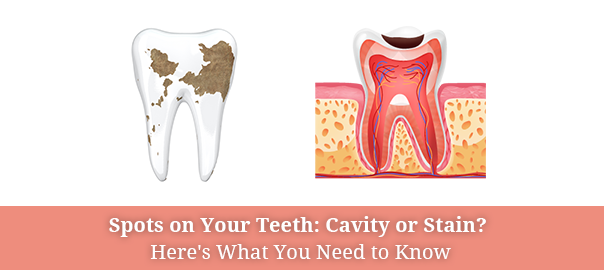
Spots on Your Teeth: Cavity vs Stain? Here’s What You Need to Know
Have you ever noticed dark spots on your teeth and wondered what they might be? Many patients worry when they see discoloration, unsure if they’re dealing with a cavity vs a stain. Knowing the difference is important because it helps you decide whether you need to see a dentist right away or just step up your cleaning routine.
Understanding the Fundamental Differences in Cavity vs Stain
Tooth stains and cavities, while sometimes similar in appearance, represent vastly different dental conditions. Stains affect the tooth’s external appearance without compromising its structural integrity. Cavities, however, indicate active decay that progressively damages the tooth’s surface, potentially creating permanent holes if left untreated.
Key Identifying Characteristics
Pattern and Spread
Stains usually show up across several teeth or cover most of a tooth’s surface. They might get darker or lighter depending on what you eat or drink. Cavities typically appear as specific dark spots, usually brown, black, or gray, and often affect just one area of a tooth.
Symptomatic Differences
What You Feel
Your body gives you clear signals when you have a cavity:
- Pain when eating hot or cold foods
- Ongoing tooth pain
- Visible holes you can see or feel
- Pain that gets worse over time
With stains, you won’t feel any pain. In fact, stains:
- Don’t hurt at all
- May fade with brushing
- Don’t damage your tooth
- Might change based on your diet
Causative Factors
Understanding the root causes helps in proper identification and treatment. Stains primarily result from external factors such as:
- Regular consumption of pigmented beverages (coffee, tea, wine)
- Tobacco use
- Certain medications
- Natural aging processes
Cavities form differently. They happen when bacteria in your mouth create acid that eats away at your teeth. You’re more likely to get cavities if you: – Don’t brush regularly – Eat lots of sugary foods – Don’t get enough fluoride
Treatment Approaches and Prevention
The treatment pathway differs significantly between stains and cavities. Stains often respond well to professional cleaning, whitening procedures, or lifestyle modifications. Cavities, however, require professional intervention through fillings, crowns, or in severe cases, root canal treatment.
Preventing Problems
Prevention remains crucial for both conditions. Maintaining excellent oral hygiene through
- Brushing twice daily with fluoride toothpaste
- Flossing every day
- Visiting your dentist regularly
All these steps form the foundation of prevention. Additionally, limiting exposure to staining agents and maintaining a balanced, low-sugar diet helps prevent both issues.
Why This Matters
Stains don’t hurt or make you uncomfortable, but they might make you feel concerned about your smile. However, if left untreated, cavities can cause major issues. They may result in tooth loss, infections, and excruciating pain.
Professional Evaluation
Even though this blog equips you with information to understand the cavity vs stain difference, it can never be the replacement for an expert eye. Only a dentist via clinical and radiographic examinations can tell for sure if you have a stain or cavity. Which is why never underestimate the importance and long term benefits of regular check ups. It helps spot problems early on, saving one’s time, money and discomfort in the long run.
Key Takeaway
Understanding the cavity vs stain distinction is crucial for your dental health. Keep in mind that simpler, less costly treatments are often the outcome of early detection of dental issues. You should visit a dentist right once if you notice any spots on your teeth, especially if they hurt. Just type “Dentist Near Me” into Google, and one of our Clove specialists will show up, prepared to assist you.
Leave a Reply
Leave a Reply
Explore More Similar Posts
Explore More Blogs


Leave a Reply